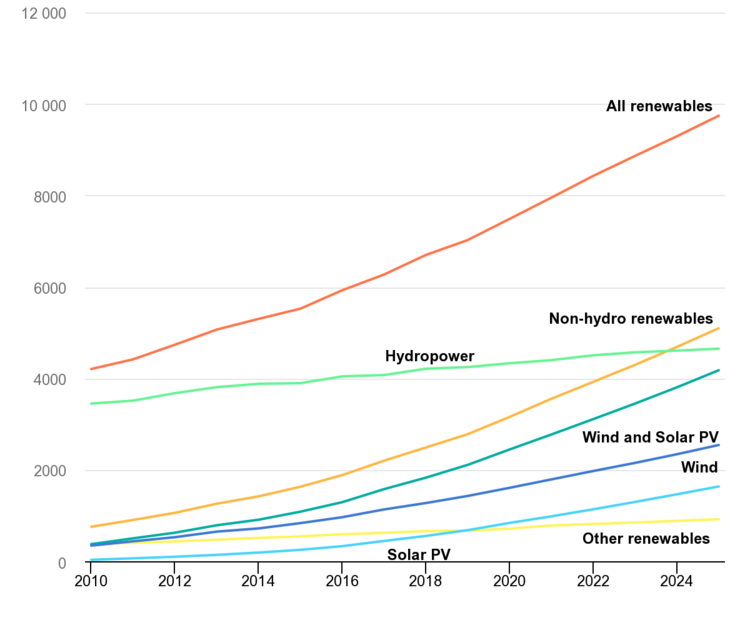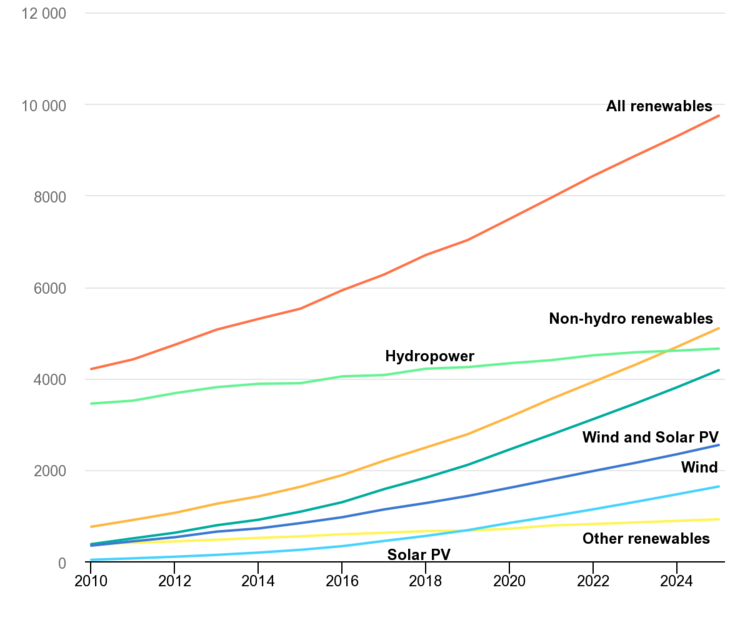Ann Arbor (Informed Comment) – The International Energy Agency’s report on electricity markets is out and it has some good news.
Depending on how cold the winters are, the IEA expects renewable sources of energy to outstrip coal in 2024, and forever thereafter. It calls this change “structural.” That is, it isn’t a blip or something that could easily be reversed. We are entering a world where people will routinely get more electricity from wind, solar, water and battery than from dirty coal. While Asia is still somewhat wedded to coal and China is even still building new coal-fired power plants, this slight increase in use will be more than offset by the rapidly dwindling numbers of coal-fired plants in the US and Europe. So IEA expects coal use to decline over the next couple of years, and that renewables will go on growing from strength to strength.
China and India account for 80% of all planned coal plants, and as renewables fall in price and the true cost of coal in the form of global boiling becomes ever more apparent, both may scale back coal projects. In fact, India is considering halting all new coal plant planning except for those facilities already committed to. Right now, coal accounts for about a third of global power generation, but it is on a steep path to decline.
Global electricity demand growth is muted in 2023, but may take off again next year. IEA expects all extra electricity demand to be met by renewables this year and next.
And next year, for the very first time fully 33% of global power will be generated by renewables. And coal generation will fall below that benchmark, heading toward zero by 2050 (if we know what is good for us).
The world has made incredible progress on the renewables front in the past decade, as this IEA chart demonstrates:

IEA, Renewable electricity generation by technology, 2010-2025, IEA, Paris https://www.iea.org/data-and-statistics/charts/renewable-electricity-generation-by-technology-2010-2025, IEA. Licence: CC BY 4.0.
Carbon dioxide pollution from burning coal and fossil gas are expected to fall this year and next. If this expectation is met, it could signal that our CO2 emissions are leveling off in preparation for declining. If you look at the period 2019-2024, the report says, fossil fuel use will have fallen in 4 out of the 6 years. The authors expect coal and gas will just go on declining from here on in, even in years when demand for electricity increases. The extra demand will be met by renewables.
There are some paradoxes in the current situation to which they attend.
Because of extensive use by Australians of roof-top solar along with utility-scale solar, the price of electricity fell below zero 20% of the time in 2022, compared to 1% of the time in the Netherlands and Germany. For the price to fall below zero means that there is not enough storage capacity to smooth out the ups and downs of production, and states need to up their megabattery game substantially.
Another problem is that global heating is causing people to run air conditioners more. But if they run their ACs off coal and fossil gas, they are putting more heat-trapping CO2 into the atmosphere, which will heat up the earth more, so that they’ll have to turn up the AC more, and on and on in a vicious cycle. Obviously, everybody should be running their AC off renewable electricity, and probably this ideal can only be attained with government investment. Still, individuals can pitch in. In most parts of the US, e.g., if a homeowner is going to be in their house for 10 years or more, they will save money by putting up rooftop solar panels. If they drive an EV and fuel it from the panels that will speed the pay-back time even more. The panels can pay for themselves in as little as 6 years.
Finally, global heating causes drought as well as faster evaporation from bodies of water, so one of the three biggest sources of renewable power, hydro, is actually in danger of declining. Globally, hydropower has dropped from 38% to 36% since 1990. Governments should plan on continued decreases in hydropower, ensuring that it is replaced by wind and solar, not by fossil fuels.



 © 2025 All Rights Reserved
© 2025 All Rights Reserved